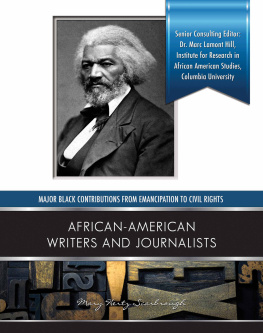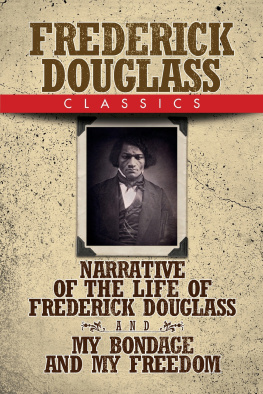
AFRICAN-AMERICAN
WRITERS AND
JOURNALISTS
MARY HERTZ SCARBROUGH
TITLES IN THIS SERIES
AFRICAN-AMERICAN ACTIVISTS
AFRICAN-AMERICAN ARTISTS
AFRICAN-AMERICAN EDUCATORS
AFRICAN-AMERICAN MUSICIANS
AFRICAN-AMERICAN SCIENTISTS AND INVENTORS
AFRICAN-AMERICAN WRITERS AND JOURNALISTS
AFRICAN AMERICANS IN BUSINESS
AFRICAN AMERICANS IN LAW AND POLITICS
AFRICAN AMERICANS IN THE MILITARY
AFRICAN AMERICANS IN RADIO, FILM, AND TV ENTERTAINMENT
AFRICAN AMERICANS IN SPORTS
A HISTORY OF THE CIVIL RIGHTS MOVEMENT
AFRICAN-AMERICAN WRITERS
AND JOURNALISTS

MARY HERTZ SCARBROUGH

MASON CREST
PHILADELPHIA
 | Mason Crest
370 Reed Road, Suite 302
Broomall, PA 19008
www.MasonCrest.com |
Copyright 2013 by Mason Crest, an imprint of National Highlights, Inc.
All rights reserved. No part of this publication may be reproduced or transmitted in any form or by any means, electronic or mechanical, including photocopying, recording, taping, or any information storage and retrieval system, without permission from the publisher.
Printed and bound in the United States of America.
CPSIA Compliance Information: Batch #MBC2012-6. For further information, contact Mason Crest at 1-866-MCP-Book.
First printing
1 3 5 7 9 8 6 4 2
Library of Congress Cataloging-in-Publication Data
Scarbrough, Mary Hertz.
African American writers and journalists / Mary Hertz Scarbrough.
p. cm. (Major Black contributions from emancipation to civil rights)
Includes bibliographical references and index.
ISBN 978-1-4222-2376-5 (hc)
ISBN 978-1-4222-2389-5 (pb)
1. African American authorsBiographyJuvenile literature. 2. African American journalistsBiographyJuvenile literature. 3. African AmericansIntellectual lifeJuvenile literature. I. Title.
PS153.N5S33 2012
810.9'896073dc23
2011051951
Publishers note: All quotations in this book are taken from original sources, and contain the spelling and grammatical inconsistencies of the original texts.
Picture credits: courtesy Berea College: .
TABLE OF CONTENTS
by Dr. Marc Lamont Hill,
Institute for Research in African American Studies at Columbia University.

Dr. Marc Lamont Hill
I t is impossible to tell the story of America without telling the story of Black Americans. From the struggle to end slavery, all the way to the election of the first Black president, the Black experience has been a window into Americas own movement toward becoming a more perfect union. Through the tragedies and triumphs of Blacks in America, we gain a more full understanding of our collective history and a richer appreciation of our collective journey. This book series, MAJOR BLACK CONTRIBUTIONS FROM EMANCIPATION TO CIVIL RIGHTS, spotlights that journey by showing the many ways that Black Americans have been a central part of our nations development.
In this series, we are reminded that Blacks were not merely objects of history, swept up in the winds of social and political inevitability. Rather, since the end of legal slavery, Black men and women have actively fought for their own rights and freedoms. It is through their courageous efforts (along with the efforts of allies of all races) that Blacks are able to enjoy ever increasing levels of inclusion in American democracy. Through this series, we learn the names and stories of some of the most important contributors to our democracy.
But this series goes far beyond the story of slavery to freedom. The books in this series also demonstrate the various contributions of Black Americans to the nations social, cultural, technological, and intellectual growth. While these books provide new and deeper insights into the lives and stories of familiar figures like Martin Luther King, Michael Jordan, and Oprah Winfrey, they also introduce readers to the contributions of countless heroes who have often been pushed to the margins of history. In reading this series, we are able to see that Blacks have been key contributors across every field of human endeavor.
Although this is a series about Black Americans, it is important and necessary reading for everyone. While readers of color will find enormous purpose and pride in uncovering the history of their ancestors, these books should also create similar sentiments among readers of all races and ethnicities. By understanding the rich and deep history of Blacks, a group often ignored or marginalized in history, we are reminded that everyone has a story. Everyone has a contribution. Everyone matters.
The insights of these books are necessary for creating deeper, richer, and more inclusive classrooms. More importantly, they remind us of the power and possibility of individuals of all races, places, and traditions. Such insights not only allow us to understand the past, but to create a more beautiful future.


This mural depicts the Revolutionary War-era surveyor, inventor, and astronomer Benjamin Banneker, who wrote and published a successful almanac during the 1790s.
I n 1619, ships with Africans on board began to land in the British colonies in North America. These Africans did not ask to come to America. They were forced to come. Once here, they were forced to work. These first Africans might have been slaves. Its also possible they were servants who would gain their freedom after working for a certain number of years. Soon, however, slavery was a part of life in America. The system of slavery lasted nearly 250 years, until after the American Civil War (18611865).
African-American slaves often werent allowed to read or write. Although there were some free blacks in America, they generally had few opportunities to attend school, either. For that reason, some of the first African American writers could neither read nor write. Those who couldnt write told others who could what to write. Some, but not all, of the earliest black American writers were slaves.
In 1746, a female slave named Lucy Terry made up a poem. This is the first known poem by an African American. It was about an Indian attack near Terrys home. Two families were killed. For many years people passed along the poem by singing it and repeating it. Lucys poem wasnt written down and published until more than 100 years after her death.
THE FIRST PUBLISHED WORDS
The first published writing by African Americans appeared about 15 years after Lucy Terry composed her poem. Briton Hammon, a black slave from Massachusetts, wrote about his adventures. He was on a ship that sank off the coast of Florida. Hammon escaped in a small boat, but was then captured by Native Americans. They sold him to a Spanish captain, who took Hammon to the Spanish settlement at St. Augustine, Florida. While there he was held in a dungeon and forced to work as a slave. Hammon eventually gained his freedom. He traveled to London, then back to New England, where he was reunited with his former master. Hammons story was published in Boston in 1760.
Next page













